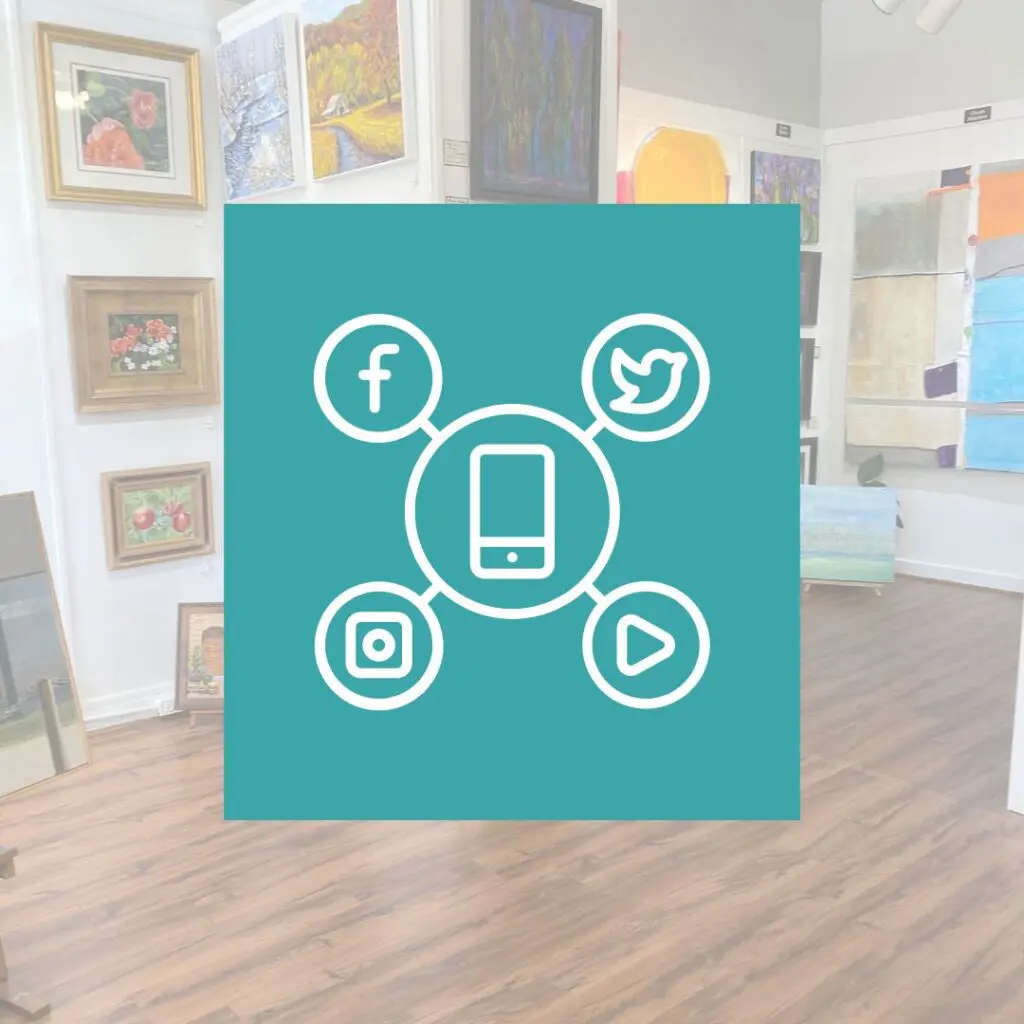In the increasingly crowded and fast-paced digital world, standing out on social media is a challenge. Ok – sometimes downright exhausting. Collectors of high-end goods often approach purchases differently than casual shoppers. They expect a thoughtful, personalized experience, clear communication, and a sense of trust and expertise before committing to a new work. That, along with building awareness of your artists and gallery, is your goal for social media.
When used well, it can help your gallery sway buying decisions, draw in serious collectors, and strengthen loyalty with your current audience. Social platforms are also a great way to boost your brand’s visibility, stand out from other galleries, and grow a solid email list of potential buyers.
Let’s explore how to create social media campaigns that deliver on these goals. In this article, you’ll learn how to design strategic social media campaigns that:
- Influence art-buying decisions
- Differentiate your gallery from competitors
- Grow your email list
- Deepen collector relationships
Why Social Media Still Matters in High-End Art Sales
Despite social media’s reputation as a space for entertainment and casual scrolling, it plays a powerful role in the decision-making process for luxury buyers. Art collectors use social platforms to research, observe, and form impressions long before they ever contact a gallery. Once you pique their curiosity, they may follow you for months before taking the next step in the sales journey. They want to feel educated and confident in their choices, particularly when considering artists they don’t yet know well. Social media offers the ideal setting for galleries to meet those needs.
By consistently posting meaningful and entertaining content, you can help followers feel more connected to your artists, informed about your program, and reassured about the value of the work you represent. This level of connection can really influence what collectors ultimately choose for their living spaces.
Campaign Thinking: Why You Need Organized Messaging
Think of a social media campaign as a structured series of posts crafted to achieve a specific result—getting RSVPs for an opening, selling artwork, or adding new subscribers to your email list. You might associate “campaign” with paid advertising, the term simply refers to a coordinated effort. Paid posts can and should be part of your strategy, but organic content—when thoughtfully planned—can also drive powerful results.
The key is to organize your posts around a single theme or objective. For example, an upcoming exhibition, a new artist on your roster, or a special event can each be the focus of a social campaign. Instead of relying on sporadic promotion, campaigns give your gallery the opportunity to tell a full story over time—building anticipation, generating engagement, and driving action.
When you use structured art gallery social media campaigns, along with evergreen content about your gallery’s brand, services and value proposition, you will have a very power gallery social media strategy.
Four Ways to Influence Art Buying Decisions on Social Media
While it may seem intuitive, many galleries fall short of using social media to its full potential when it comes to converting followers into buyers. That’s often because their content isn’t aligned with the factors that actually influence purchase decisions. Posting regularly is not enough. To be effective, your messaging must educate, build trust, demonstrate value, and reflect a high level of service.
- One of the most impactful strategies is education. Use your social posts to explain why an artist’s work matters, how it fits within broader movements, or what makes it technically or conceptually compelling. This type of content not only positions your gallery as a knowledgeable expert of the art world but also helps collectors feel more confident in their choices.
- Building interest over time is equally important. Rather than relying on a single announcement, use your campaign to slowly reveal elements of an exhibition or artist’s story. As curiosity builds, so does emotional investment. That emotional connection is often what turns a passive viewer into an active buyer.
- Service also plays a key role in buyer influence. Your followers are observing not just what you post but how you respond. Demonstrating prompt, professional, and friendly communication on social media signals that your gallery is trustworthy and easy to work with. In a world where service expectations are high, responsiveness can be the difference between a lost opportunity and a new collector.
- Finally, relationship-building is critical. Social media shouldn’t be treated solely as a promotional tool—it should be a space where dialogue happens. Ask questions in your captions. Share personal perspectives from curators or artists. Celebrate milestones with your collectors. All of these approaches help nurture long-term relationships that go far beyond a single transaction.
Planning Campaigns Around Gallery Events
Gallery events such as exhibition openings, fair booths, and artist talks are natural focal points for structured social media campaigns. However, many galleries underestimate the importance of long-term planning. Given the fleeting nature of social posts and ever-changing algorithms, a single announcement will likely go unnoticed by a large portion of your followers.
Start planning at least two to three months before an event. Begin by creating a social media calendar that outlines post topics and timing from the early awareness stage through post-event follow-ups. For an exhibition, early posts might focus on behind-the-scenes moments in the studio or concept development. As the show nears, shift your messaging to include save-the-dates, artist bios, and teaser images of the work. During the exhibition, showcase opening night moments, video walkthroughs, and visitor reactions. Afterward, highlight any press coverage, share sold works (when permitted), and remind followers of what’s still available.
Social Media Campaign Example: Promoting an Art Exhibition
Let’s say your gallery is launching a new solo show. Here’s how a structured 6-8 week campaign might look:
Pre-Exhibition Content
- Multiple “Save the Date” posts and RSVP invitations
- Artist features and studio previews
- Background on the theme or medium
- Staff picks and personal insights
- Video walkthroughs or Instagram Lives
During the Show
- Opening night photos and short clips
- Press coverage or artist talks
- Highlights of key works (especially if they’re still available)
- “Only 2 weeks left” countdowns
Post-Exhibition
- Recap videos or image galleries
- Testimonials from attendees or buyers
- Share stories behind sold works
- Invite followers to join your mailing list for future previews
Throughout the campaign, repetition of key messages is crucial. In today’s digital climate, people need to see something several times before it truly registers. Keep returning to your core messages—why the artist matters, why the exhibition is unique, and why now is the time to engage.
The Role of Visual Storytelling
In social media marketing, visuals do more than capture attention—they communicate lifestyle, quality, and emotional resonance. This is especially important when selling high-value art. Collectors are drawn not just to the work itself, but to the narrative and values surrounding it. A powerful image or short video can immediately express what words cannot.
While image posts still have value, video content tends to perform better across platforms and allows for deeper storytelling. Studio tours, artist interviews, behind-the-scenes installations, and collector testimonials are all compelling formats that reinforce the professionalism and vibrancy of your gallery.
Whenever possible, choose visuals that reflect the lifestyle associated with collecting fine art. This might include photos of artwork installed in beautiful interiors, scenes from exclusive openings, or clips of artists working on large-scale commissions. These images help reinforce the aspirational aspects of buying art and strengthen your gallery’s brand identity. It’s great to ask your buyers for images of a piece installed in their space to share on your social platforms. Real-world lifestyle visuals are better than AI visuals when you can get them.
Standing Out on Social Media from Similar Galleries
One of the greatest benefits of using social media strategically is the ability to differentiate your gallery from others in your market. While many galleries share similar types of content—event photos, new arrivals, artist news—very few take the time to express what makes their program and philosophy truly distinct. That kind of messaging can really help move the needle and drive more sales.
Use your posts to communicate your gallery’s values and curatorial voice.
- What drives your programming decisions?
- Why do you represent the artists you do?
- What is the tone and approach of your exhibitions?
Sharing this kind of context allows collectors to form a deeper understanding of your gallery—and can be the deciding factor when choosing between one space or another.
Let your personality show, too. Whether it’s a gallery associate’s favorite work from a show or a behind-the-scenes moment from installation day, human touches create connection. They also signal authenticity, something that art buyers value highly.
Growing Your Art Gallery’s Email List Through Social Media
Social media is a great way to grow your email list—if you include clear and consistent invitations. Many galleries miss the opportunity to convert followers into subscribers simply because they don’t ask. Use your bio, captions, and story highlights to regularly encourage sign-ups. Make the benefits clear: exclusive previews, early access to new works, or invites to private events can be compelling incentives, but the more creative the better. Many calls to action for signing up for a gallery newsletter sound way too similar.
Don’t forget to use calls-to-action during major campaigns, too. For example, when announcing an upcoming show, include a message such as “Join our list for a first look at new work before the public opening.” You can also share behind-the-scenes content with subscribers only, giving followers a reason to stay connected beyond the social feed.
The goal is to bring social media followers deeper into your world, where your gallery has more control over communication and a better chance of nurturing a meaningful relationship. You have a much stronger chance of your newsletter being received and read than an algorithm showing your post on a follower’s feed. This is why it is a no-brainer to invite followers often to join your mailing list.
Next Steps for Your Gallery
- Review your exhibition calendar and identify opportunities for structured campaigns
- Create a content calendar that covers your messaging across all your marketing channels – Social media, newsletter, website, etc.
- Set monthly goals for follower growth, email list conversions, or engagement
- Invest time in planning and content production, especially video
- Track results—then refine your strategy to focus on what’s working
Your ideal buyers are already on social media. Your job is to meet them there with compelling stories, consistent value, and a reason to trust your gallery with their next acquisition.
To the Point
At its best, social media isn’t about shouting into the void—it’s about creating influence. Through thoughtful, structured campaigns, your gallery can shape perception, educate potential buyers, showcase your unique identity, and move people closer to a sale.
Think of your social media as an extension of the gallery space: it should feel welcoming, intelligent, personal, and above all, aligned with your brand. With the right strategy, social media can become one of your most valuable tools for attracting new collectors, fostering lasting relationships, and driving revenue growth.
Check out the Content Marketing Annual Planner to help you plan your art gallery’s social media campaigns.



Leave a Reply